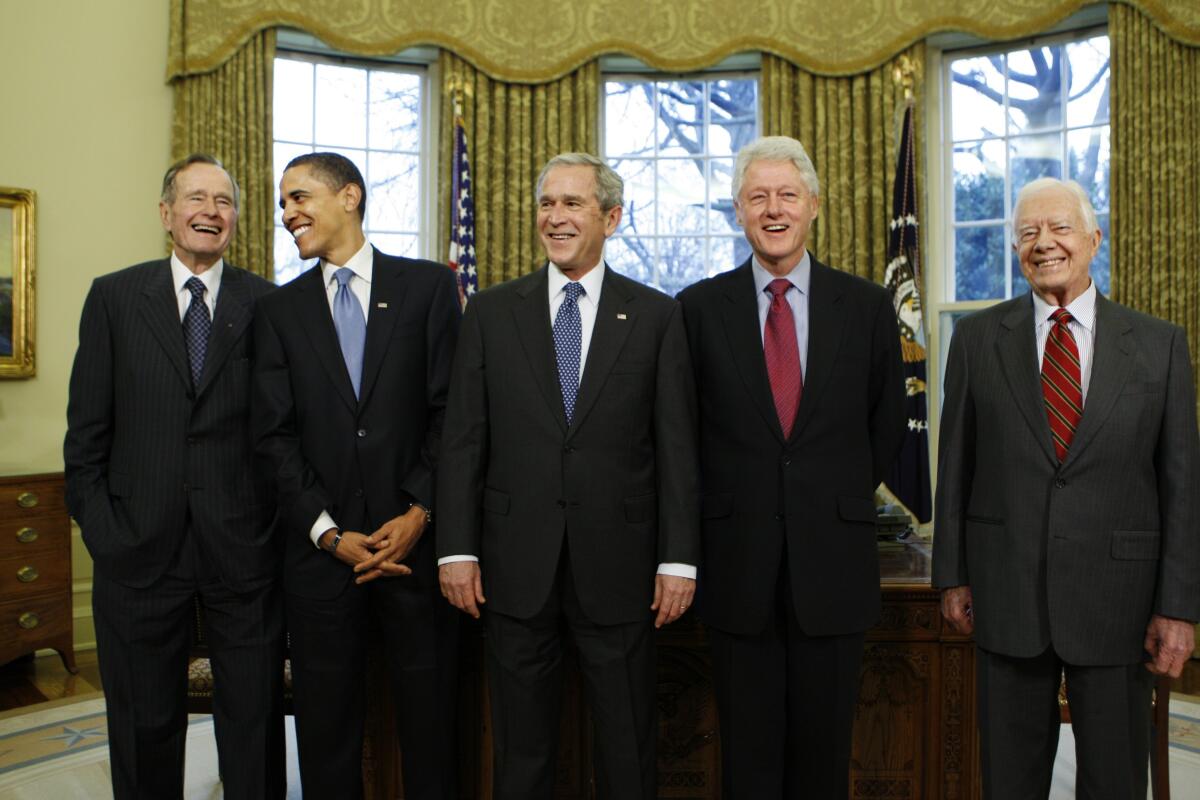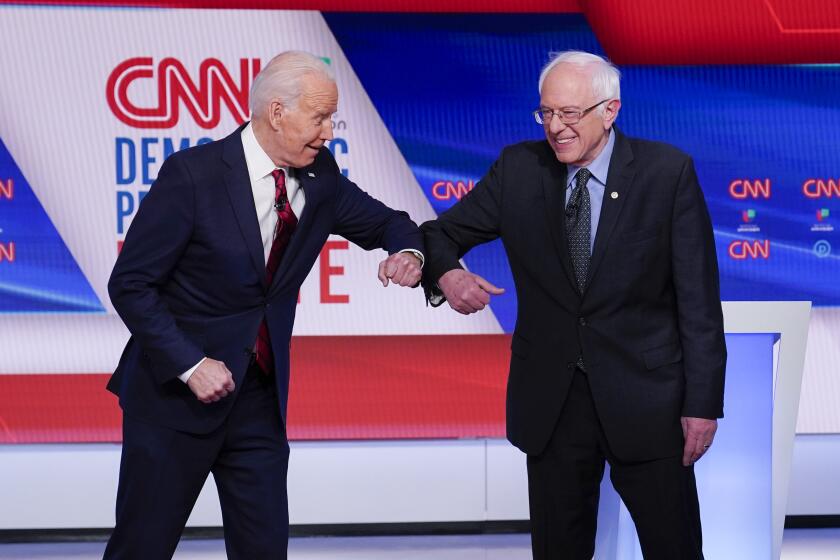Trump is dismantling nuclear arms control. Bad idea

- Share via
WASHINGTON — Almost unnoticed in the coronavirus crisis, President Trump is systematically demolishing a cornerstone of global stability: the system of nuclear arms control agreements between the United States and Russia.
Last week, the Trump administration announced its intention to withdraw from the Open Skies Treaty, which allowed Russia, the United States and European countries to fly surveillance aircraft over each other’s territory to ensure no one was planning a sneak attack.
Last year, the president pulled out of the Intermediate Nuclear Forces treaty, which prohibited the United States and Russia from stationing medium-range missiles in Europe.
Bernie Sanders, belying a reputation among many Democrats as a loose cannon, is stepping up to persuade his skeptical followers to support Joe Biden for president.
Next on his agenda is the most important remaining arms treaty, known as New START, which limits the United States and Russia each to 1,550 warheads for long-range missiles, bombers and submarines.
The pact expires in February. If it is allowed to lapse, there will be no arms control agreement in force between the world’s two biggest nuclear powers for the first time since 1972 — almost half a century.
White House officials don’t seem worried by that. Trump has called New START, which was negotiated by President Obama in 2010, “one-sided” and a “bad deal.”
His arms negotiator, Marshall Billingslea, said last week that the administration may not extend the treaty unless verification provisions are improved. He charged that Russia has taken advantage of “loopholes” in the pact.
If a new deal can’t be struck, he said, the United States is ready and willing to engage in a nuclear arms race.
“We know how to win these races and we know how to spend the adversary into oblivion,” he said at the Hudson Institute, a Washington think tank. “If we have to do it, we will. But we would like to avoid it.”
That — as Billingslea must have known — was an echo of something Trump said as president-elect in 2016, explaining why he wants to expand the nuclear arsenal.
“Let it be an arms race,” he told MSNBC. “We will outmatch them at every pass and outlast them all.”
Once in office, Trump repeatedly asked aides why the United States shouldn’t have more nuclear weapons, according to “The Bomb,” a book by nuclear historian Fred Kaplan.
Since then, the administration has accelerated programs to modernize the existing nuclear arsenal and has added a new class of low-yield warheads to its submarine fleet.
Billingslea insisted that the administration is serious about negotiating a new treaty, but he outlined ambitious goals that will be virtually impossible to reach by February.
In addition to tougher verification requirements, he said the United States wants Russia to include short-range battlefield weapons under the new agreement, a step Moscow has rejected.
Even more difficult, he said the United States wants Russia to persuade China to join the negotiations to make it a three-way deal.
Beijing has deployed about 300 strategic nuclear weapons, far fewer then Washington or Moscow. China appears to want to double its arsenal to about 600 warheads, Billingslea warned.
But China has repeatedly said it’s not interested in arms control talks — apparently because it fears joint U.S.-Russian pressure to keep its arsenal permanently small.
Billingslea “didn’t suggest anything that would make the Russians or Chinese want to come to the table,” Steven K. Pifer, a former U.S. arms control negotiator now at Stanford’s Freeman Spogli Institute for International Studies, told me. “Besides, why would they make concessions when there’s a presidential election in five months?”
What happens if the START agreement lapses?
Probably not an immediate, large-scale arms race — if only because both the United States and Russia will face budget problems coming out of the coronavirus crisis.
But over time, the loss of the verification regime, whatever its flaws, will create mutual suspicion on both sides and pressure to deploy more nuclear warheads.
“If there’s uncertainty about what one side is building, it’s reasonable for the other side to rely on worst case scenarios,” said Scott Sagan, another Stanford expert.
And if the Trump administration resumes underground testing of nuclear weapons for the first time since 1992, as it is reportedly considering, that will create even more instability.
“That won’t just encourage Russia to test again; it will ensure that China, India and Pakistan resume testing too – and the world will be in far greater danger,” Sagan said.
From Nixon through Obama, every president sought nuclear arms control agreements with Russia to reduce global tensions, limit the chances of accidental war and cut the costs of maintaining a nuclear arsenal.
Trump doesn’t seem interested in those goals. He’s never spoken publicly at any length about nuclear weapons, except his occasional statements emphasizing that he wants the United States to be No. 1.
He’s long believed the United States doesn’t use the leverage of its military power enough to force other countries to bend to our will. He’s cast himself as the world’s disruptor in chief, sweeping aside international agreements that he thinks tie his hands.
“The president has a long and successful career as a negotiator, and he’s a master at developing and using leverage,” Billingslea said in a vigorous display of loyalty.
But there’s little evidence to back up that optimistic view. The president has landed relatively modest trade deals with Mexico, Canada and China, but real diplomatic triumphs have eluded him.
Trump tried for a grand bargain with North Korea’s Kim Jong Un, and came away with nothing. He deputized his son-in-law, Jared Kushner, to negotiate peace between Israel and the Palestinians; nothing again. He tore up Obama’s 2015 nuclear deal with Iran and promised to replace it with something better; we’re still waiting.
A better nuclear arms deal, if he really wants one, is well worth getting.
His record does not inspire confidence that he can deliver.
More to Read
Sign up for Essential California
The most important California stories and recommendations in your inbox every morning.
You may occasionally receive promotional content from the Los Angeles Times.















